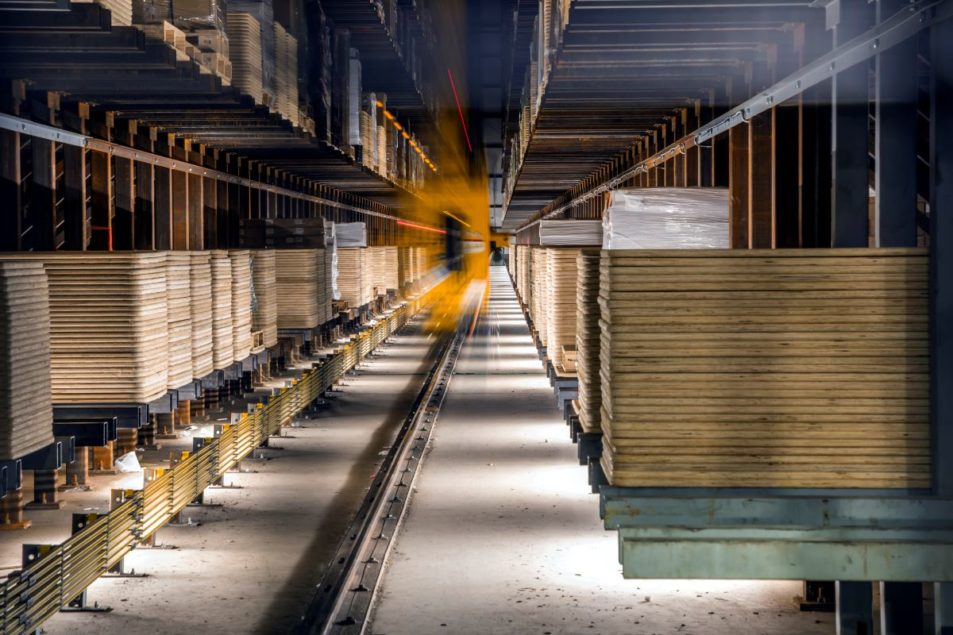
Companies are shifting towards faster, smarter and more sustainable productivity. Global supply chain warehouse professionals are being drawn in by the promise of Industry 4.0 as an industrial revolution seeking to increase productivity, reduce costs and accelerate go-to-market timelines. The U.S. and Canada currently sit at the forefront of this global revolution, according to Verified Market Research, where the market size is expected to grow to $317 billion by 2030.
This shift begs the question: How can businesses adopt new technology and innovate effectively? The ultimate goal is to design warehouses that balance human workers with the use of automated technology. To realize the benefits of Industry 4.0 when designing your next warehouse, bear in mind these four principles: balance data and materials, make work joyful through beautiful workspaces, enable an operational vision, and achieve true machine collaboration through open architecture.
Balancing Digital Transformation with the Material Demands of Warehouses
Using new technology and digitization can make things run faster and save time. Intelligent software allows systems to talk to each other to accomplish specific tasks without the need for assistance from humans. Imagine machines having a little chat and making preemptive decisions based on their conversation, like fixing themselves or keeping things safe from cyber issues.
But here's the thing; it's a mistake to think that smart software alone can solve every challenge and make a warehouse highly productive. Boxes aren't always the same — they can bend, move, and change shape. You shouldn’t only think in terms of ones and zeros. You need to consider the real, physical items involved in material handling. Even in the most tech-savvy warehouses, you have to understand the physical materials you're working with. Are they different in size, quality or maybe a bit damaged? Can your autonomous systems handle the variations? One way to achieve high up-time and low capital investment is to minimize the variations in packaged materials.
Automation likes consistency, so if you want smooth operations and reduced costs, try to make everything uniform for the machines. Striking the proper balance between the value of data and the value of materials to be handled is essential for planning the most productive floor layout. Data and materials are important factors to consider when planning a new warehouse layout, but the humans working alongside these systems are the most critical.
Beautiful Spaces Inspire Workers, Drive Recruitment
In a way, Industry 4.0 is creating the same shift in warehouses that office spaces underwent during the tech boom of the late 1990s and early 2000s. The explosion of tech startups led to more relaxed office spaces that focused on fostering innovation and creativity, leading to more open and collaborative workplaces.
We saw another cultural shift in 2020, brought on by COVID-19. Workers shifted to remote work out of necessity, but that did not include warehouse workers who were deemed essential. Now, almost four years later, the U.S. economy is still finding the best balance between remote and in-person work.
It’s time to shift our focus to the people who work in warehouses, who are the essential personnel, ensuring things like our next-day Amazon Prime deliveries. But you can’t put loungers and a coffee bar in the middle of your warehouse floor, so how can you inspire warehouse workers in similar ways? Focus instead on creating beautiful spaces that inspire workers and allow them to enjoy their time on the job.
Earlier this year, Configura shared insights from a survey of material-handling professionals across the U.S., Germany and Japan. When asked about design review methods, 89% of respondents stated they still are using .pdfs and PowerPoints to try to visualize their future spaces. Designers need tools that provide realistic visualizations of what a warehouse environment will look like that focus on ideation and visualization in 3D. Full video renderings for designers can help create an immersive experience before warehouses are built.
Filling an Expanding Labor Shortage
We’re facing a time when fewer people want to work in the manufacturing sector, and more jobs are going unfilled. The number of workers in warehousing and storage is growing, but not fast enough. Although the U.S. Bureau of Labor Statistics reported 1.9 million active warehouse workers in November 2023, up from 1.6 million in the category in early 2020, the National Association of Manufacturers predicts a gap of more than 2 million workers by 2030. The bottom line is that the manufacturing sector cannot afford to lose any more workers, and research has shown that an aesthetically pleasing workplace can drive recruitment, job satisfaction, and even productivity.
The shift in workplaces that took place during the tech startup boom was due, in part, to a rise in millennials joining the workforce at the time. Now we’re seeing Gen Z enter the workforce and, by 2025, it is expected that they will make up one-quarter of the global workforce, according to McKinsey & Company. This increasingly significant generation of workers has different expectations, including mainly interactive, tech-first work environments.
Future-Proof Your Warehouse with a Central Command Center
The way administrators monitor employees and conduct oversight of complex systems is undergoing a transformation in the era of Industry 4.0. Future-forward warehouses are adopting command-center-like spaces equipped with multiple live monitors and real-time machine diagnostics systems, ensuring optimal up-time and throughput. Leading solutions providers are at the forefront of integrating industrial automation control centers into warehouses, emphasizing the importance of "future-proofing your warehouse."
The strategic placement of a central command and monitoring center within the physical space becomes pivotal in operations where a combination of IoT-enabled equipment, AI toolsets, and human leaders are crucial for effectiveness. This center may be positioned at the heart of the floor plan or elevated on a mezzanine level to oversee the physical operation. In either design, the incorporation of strategically located cameras and visualization tools enhances the oversight capabilities within a warehouse. Many manufacturing execution systems (MES), warehouse control systems (WCS), or warehouse management systems (WMS) now leverage visualizations that offer a heightened level of operational oversight, leading to increased productivity and efficiency.
Put Connections and Collaboration Top of Mind in Your Warehouse Design
In Industry 4.0 warehouses, everything works together like a well-oiled machine. This includes everything from workers to IoT devices to the ventilation system. Intelligent software is able to manage tasks like receiving, storing, picking, packing, and shipping. It can even change how machines work based on what's happening at any given moment.
In order for a facility to work as seamlessly as possible, it's crucial that every part of a warehouse's system is connected to each other. If you're designing the layout of a warehouse, it's smart to use an open architecture layout. This way, you can create a digital version of a warehouse before it's built. This helps make sure everything will run smoothly when the physical warehouse is up and running and will allow for ongoing improvements. An open-architecture layout helps warehouse administrators meet goals, save money, and stay ahead in a fast-changing industry.
Preparation is the Key Success Factor
In a rapidly evolving industry focused on implementing automation, it's hard to predict what a warehouse will look like in ten years. This makes it tricky for professionals who want to get their businesses ready and stay ahead of the competition. But there are several key fundamental considerations that can help guide you toward a successful floor design:
- Balance the demands of data and materials.
- Inspire workers and drive recruitment with beautiful warehouses.
- Future-proof your warehouse with a central command center.
- Elevate connections and collaboration across workers and machines.
- Use innovative design tools to plan the space before implementation.
Designing an Industry 4.0 warehouse begins with putting people first to strengthen the industry and help carry the global supply chain forward.
Rich Trahey is VP of global sales and marketing at Configura.
- SEO Powered Content & PR Distribution. Get Amplified Today.
- PlatoData.Network Vertical Generative Ai. Empower Yourself. Access Here.
- PlatoAiStream. Web3 Intelligence. Knowledge Amplified. Access Here.
- PlatoESG. Carbon, CleanTech, Energy, Environment, Solar, Waste Management. Access Here.
- PlatoHealth. Biotech and Clinical Trials Intelligence. Access Here.
- Source: https://www.supplychainbrain.com/blogs/1-think-tank/post/38769-how-industry-40-is-interwoven-into-modern-warehouse-design
- :has
- :is
- :not
- :where
- $UP
- 1
- 19
- 2020
- 2023
- 2025
- 2030
- 3d
- 9
- a
- Able
- About
- accelerate
- accomplish
- According
- Achieve
- across
- active
- administrators
- adopt
- Adopting
- ahead
- AI
- allow
- allows
- almost
- alone
- alongside
- Although
- always
- Amazon
- an
- and
- Another
- any
- architecture
- ARE
- AS
- Assistance
- Association
- At
- Automated
- Automation
- autonomous
- autonomous systems
- Balance
- bar
- based
- BE
- Bear
- beautiful
- becomes
- before
- being
- benefits
- BEST
- between
- Billion
- Bit
- boom
- Bottom
- boxes
- brought
- built
- Bureau
- businesses
- but
- by
- cameras
- CAN
- Canada
- cannot
- capabilities
- capital
- carry
- Category
- Center
- Centers
- central
- chain
- challenge
- change
- chat
- Coffee
- collaboration
- collaborative
- combination
- competition
- complex
- Conduct
- connected
- Connections
- Consider
- considerations
- control
- Conversation
- Costs
- COVID-19
- create
- Creating
- creativity
- critical
- crucial
- cultural
- Currently
- cyber
- data
- decisions
- deemed
- Deliveries
- demands
- Design
- designers
- designing
- Devices
- diagnostics
- DID
- different
- digital
- Digital Transformation
- digitization
- drawn
- drive
- due
- during
- each
- Earlier
- Early
- economy
- effectively
- effectiveness
- efficiency
- either
- elevated
- emphasizing
- employees
- enable
- Enhances
- enjoy
- enough
- ensuring
- Enter
- Environment
- environments
- equipment
- equipped
- Era
- essential
- Ether (ETH)
- Even
- Every
- everything
- evolving
- execution
- expanding
- expectations
- expected
- experience
- explosion
- Facility
- facing
- factors
- FAST
- faster
- fewer
- finding
- First
- Floor
- Focus
- focused
- For
- forefront
- Forward
- fostering
- four
- from
- full
- fundamental
- future
- gap
- Gen
- Gen Z
- generation
- Germany
- get
- given
- Global
- Go-To-Market
- goal
- Goals
- going
- Grow
- Growing
- guide
- handle
- Handling
- Happening
- Hard
- Have
- having
- Heart
- heightened
- help
- helps
- here
- High
- highly
- How
- HTTPS
- human
- Humans
- ideation
- if
- imagine
- immersive
- implementation
- implementing
- importance
- important
- improvements
- in
- include
- includes
- Including
- Increase
- increased
- increasingly
- industrial
- industrial automation
- Industrial Revolution
- industry
- industry 4.0
- innovate
- Innovation
- innovative
- insights
- inspire
- instead
- Integrating
- Intelligent
- interactive
- into
- investment
- involved
- iot
- iot devices
- issues
- IT
- items
- Japan
- Job
- Jobs
- joining
- jpg
- keeping
- Key
- labor
- Late
- later
- Layout
- leaders
- leading
- Led
- Level
- Leverage
- like
- likes
- Line
- little
- live
- located
- Look
- look like
- lose
- Low
- machine
- Machines
- mainly
- make
- MAKES
- Making
- manage
- management
- manufacturing
- Manufacturing sector
- many
- Market
- Marketing
- material
- materials
- May..
- maybe
- McKinsey
- Meet
- methods
- Middle
- Millennials
- million
- mind
- minimize
- mistake
- Modern
- moment
- money
- Monitor
- monitoring
- monitors
- more
- most
- move
- multiple
- Nam
- necessity
- Need
- New
- next
- November
- now
- number
- of
- offer
- Office
- on
- ONE
- ones
- ongoing
- only
- open
- operation
- operational
- Operations
- optimal
- or
- order
- Other
- our
- out
- oversee
- Oversight
- packaged
- part
- People
- Personnel
- physical
- picking
- pivotal
- Place
- placement
- plan
- planning
- plato
- Plato Data Intelligence
- PlatoData
- positioned
- possible
- predict
- Predicts
- Prime
- principles
- productive
- productivity
- professionals
- promise
- proper
- provide
- providers
- put
- Putting
- quality
- question
- rapidly
- RE
- ready
- real
- real-time
- realistic
- realize
- receiving
- recruitment
- reduce
- Reduced
- relaxed
- remote
- remote work
- Reported
- research
- respondents
- review
- Revolution
- Rise
- Run
- running
- s
- safe
- sales
- Sales and Marketing
- same
- satisfaction
- Save
- saw
- seamlessly
- sector
- seeing
- seeking
- several
- Shape
- shared
- shift
- shifted
- SHIFTING
- Shipping
- shown
- significant
- similar
- sit
- Size
- smart
- smarter
- smooth
- smoothly
- So
- Software
- Solutions
- SOLVE
- Space
- spaces
- specific
- startup
- Startups
- stated
- stay
- Still
- storage
- Strategic
- Strategically
- Strengthen
- success
- successful
- supply
- supply chain
- sure
- Survey
- sustainable
- system
- Systems
- T
- Talk
- tasks
- tech
- tech startup
- tech startups
- Technology
- ten
- terms
- than
- that
- The
- their
- Them
- themselves
- There.
- These
- they
- thing
- things
- think
- this
- this year
- Through
- throughput
- time
- timelines
- to
- together
- took
- tools
- toolsets
- top
- toward
- towards
- Transformation
- true
- try
- u.s.
- U.S. economy
- ultimate
- undergoing
- understand
- underwent
- use
- using
- value
- variations
- version
- Video
- vision
- visualization
- visualize
- vp
- want
- Warehouse
- warehouse management
- Warehouse Management Systems
- Warehousing
- was
- Way..
- ways
- were
- What
- when
- WHO
- will
- with
- within
- without
- WMS
- Work
- work out
- workers
- Workforce
- working
- Workplace
- works
- year
- years
- you
- Your
- zephyrnet












